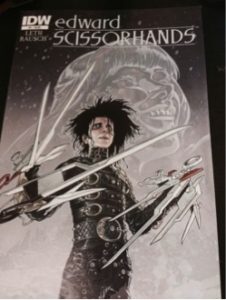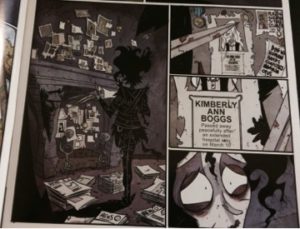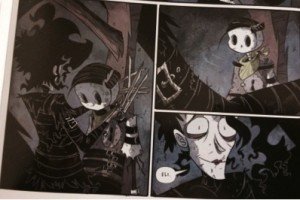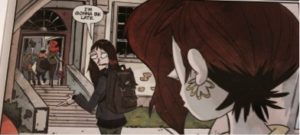Licensed comics are what dreams are made of. Seriously – aside from media tie-in novels, which seem to be dwindling in recent years, comics is the only medium that will take your long lost loves, whether it be a cancelled TV show or a cult classic movie, and pick up the ball. In recent years, comic books have been home to the “official” (usually meaning creator sanctioned) or canonical continuations of properties that began in other media, like Dark Horse’s Buffy the Vampire Slayer: Seasons Eight – Ten and IDW’s The X-Files: Season Ten. For these comics to last, the fanbase has to be passionate, dedicated in a way that transcends what being a fan of something normally means. These fans want more.
There are few fanbases as adoring as Tim Burton’s followers. Burton’s gothic masterpieces elevated the idea of isolation and strangeness to heroism, making romantic leads out of what others saw as grotesque figures, and leading men and women out of eccentric loners. Edward Scissorhands in particular, a standalone film released in 1990, spoke for a generation of kids who felt that they didn’t quite fit. A few months back, twenty-four years after the film’s release, writer Kate Leth and artist/colorist Drew Rausch teamed up for a comic book sequel that picks up Edward’s story two decades after the original.
When the new comic booky adventures of Edward Scissorhands begin, basically the entire supporting cast of the film, even Kim Boggs, is out of the picture. Kim has passed away (which we find out through a heartstring-plucky scene, where Edward puts her obit on his wall), but the focus remains on her family. The lead, besides the last guy whose hand you want to shake, is Megs, Kim’s sullen granddaughter who is obsessed with the stories she was told as a kid. Only problem is, everyone, including Megs’ mother, thinks that Kim was more or less on the delusional side of crazytown. Megs’ story, which instantly had me invested because we obviously know that Kim is right, and we want her story to be told, is a compelling tale of a misfit girl trying to get her voice heard. Very much in the spirit of Edward Scissorhands, and Burton flicks as a whole.
The Edward of it all is stranger, though every bit as compelling. He’s isolated and alone, and has been that way for a while. In interest of finding a friend after all these years, he digs up his inventor’s old books, and finds information for a protype of another creation. He finds the failed creation, brings it to life, and names it Eli. Eli, seemingly unstable, escapes and, with an inquisitive girl waiting for answers and a confused creature, not unlike Edward, on the loose, thus begins what seems to be the true story of this book. The parallels to the movie are strong, but everything feels fresh and new rather than recycled. It was a brash move setting this so long after the movie, but it adds a metatextual quality to it all that works wonderfully.
Also rather brash is the style of the art. Many licensed comics slavishly adhere to actor likeness, so I expected the same here, especially since the lead is played by Johnny Depp. Not the case. Rausch’s art captures the feel and tone of Edward Scissorhands instead, stylizing it, putting the weirdness, the emotion, and the humor to the front. It’s cartoonier than I expected, and far more dynamic and daring than I expected. The lettering, too, helps evoke an off-kilter mood that works well with Kate Leth’s gothic (one might say none more goth) yarn. This book is – for hardcore Burton fans, nostalgia hounds, or even just folks who like good comics – an insane fairy tale come true.
PAT SHAND writes comics (Robyn Hood, Charmed: Season Ten, Grimm Fairy Tales) and pop culture critique (Blastoff Comics, Sad Girls Guide). He used to sleep on a Nightmare Before Christmas pillow. He, as a grown adult person, wishes he still had said pillow.





Comments are closed.